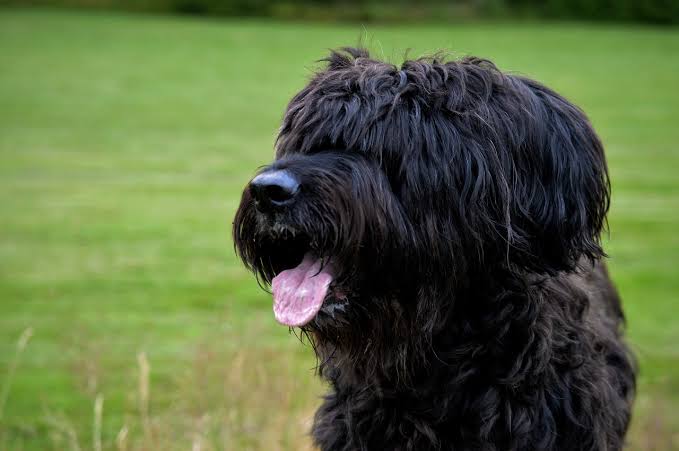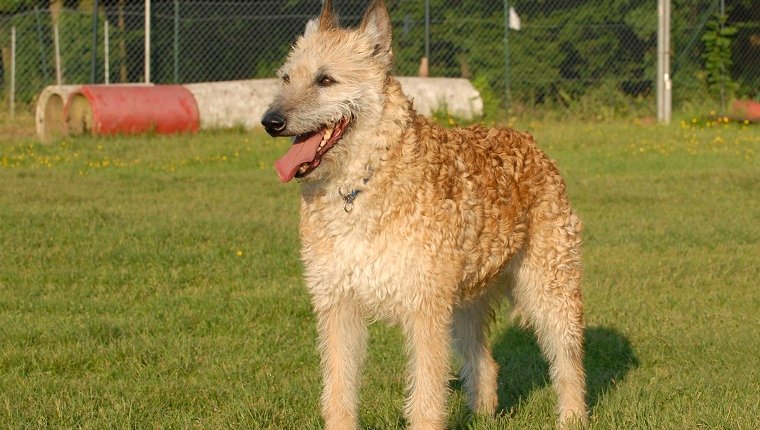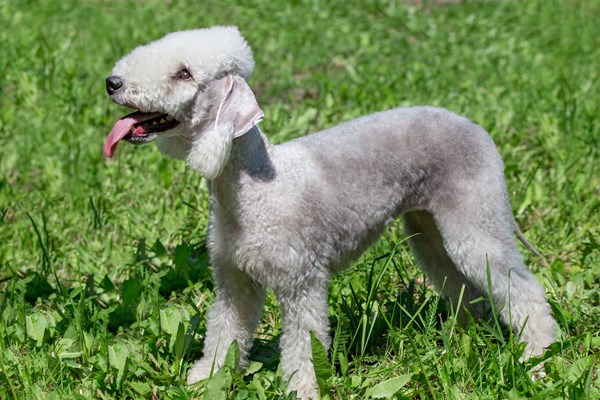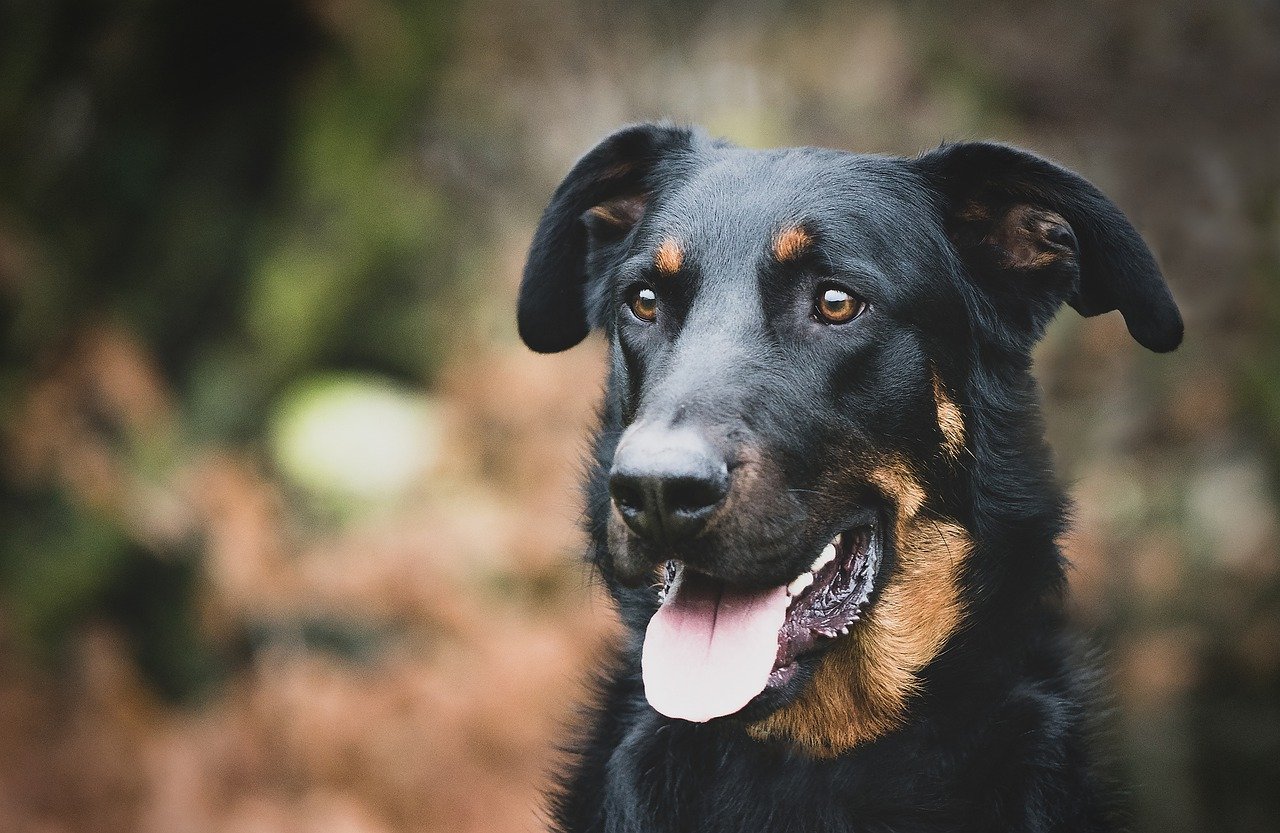Briard Dog Overview
The Briard is a breed with squares or slightly longer than tall, robust without coarse, and has a lovely form.
The Briard is a boundary herder who acts as a “moving barrier” to keep a flock contained in an unfenced region. This necessitates the dog’s ability to think for himself.
Briards are erect, wide-eyed herders. Their mobility has been described as “quicksilver,” with fluid, light strides that appear to glide.
Their undercoat is fine and tight, while their outside coat is coarse and dry, with long, somewhat wavy locks that lie flat.
The coat is at least 6 inches long on the shoulders. The larger brows, as well as the long-appearing head, contribute to the inquisitive, confident attitude.
Briard Highlights
- The Briard must be groomed on a daily basis. Despite the fact that his coat is low- to non-shedding, it tangles and mats quickly. Consider another breed if you don’t have the time or tolerance for grooming.
- If your puppy has been properly trained, the Briard is naturally autonomous, which is a beautiful attribute. However, without instruction, that self-assured puppy might grow into an uncontrollable adult.
- To avoid violence toward people or animals he does not know, the Briard must be socialized at a young age. Briards were bred and developed to be guard dogs, and they continue to take this responsibility seriously.
- The Briard adores the company of his owner. He performs best when he is permitted to spend time with the people he cares about.
Briard Breed Features & Ratings:
Rated base on a 5 Star Scale
ENERGY LEVEL: 3 Star
EXERCISE REQUIREMENTS: 4 Star
PLAYFULNESS: 3 Star
AFFECTION LEVEL: 3 Star
FRIENDLINESS TO DOGS: 1 Star
FRIENDLINESS TO OTHER PETS: 3 Star
FRIENDLINESS TO STRANGERS: 1 Star
WATCHFULNESS: 5 Star
EASE OF TRAINING: 1 Star
GROOMING REQUIREMENTS: 4 Star
HEAT SENSITIVITY: 4 Star
VOCALITY 5 Star
Briard Characteristics:
- Dog Breed Group: Working Dogs
- Height: At the shoulder, it should be 22 to 27 inches tall
- Weight: 70 to 100 pounds
- Life Span: 10 to 12 years
- Type: Purebred
- AREA OF ORIGIN: France
- DATE OF ORIGIN: 1300s
- OTHER NAMES: Berger De Brie, Berger Briard
- Temperament: Faithful, Fearless, Intelligent, Loyal, Obedient, Protective
- Activities: Herding, Police and Military Work, Search and Rescue, Conformation
- Color: Black, Gray, Tawny
- Litter Size: 8 to 10 puppies
- Puppy Prices: $1500 – $3000 USD on average
Briard Health:
Cancer, hip dysplasia, congenital stationary night blindness, alongside cataracts, corneal dystrophy, retinal folds, as well as hypothyroidism, immunological illnesses, exocrine pancreatic insufficiency, and kidney disease are all common in the Briard.
Make sure to discuss any concerns or questions you have with your breeder and veterinarian so that you can contemplate appropriate decisions about your dog’s health.
The National Breed Club recommends the following health tests:
- Hip Evaluation
- Ophthalmologist Evaluation
- Stationary Night Blindness Optigen DNA Test
Briard Grooming:
The Briard has an exterior coat and an undercoat, despite being a low- to non-shedding breed.
The exterior coat is slightly wavy and harsh in texture, measuring around six inches long, but the undercoat is soft and fine.
It comes in a range of colors or color combinations, including black, gray, and tawny. Do you have a few hours per week to devote to grooming your Briard?
If not, choose a different breed. His magnificent coat takes a lot of brushing, combing, and fussing to keep it looking well.
A thorough brushing every day, as well as a bath every six to eight weeks, is advised.
The Briard, like many dogs with fluffy coats, gets dirty easily, so expect muddy paws, leaves or burrs tracked into the home, feces on the hindquarters, or a damp and dusty beard.
If the thought of keeping up with the Briard coat overwhelms you, try hiring a professional groomer to assist you.
Regular brushings between groomings aren’t necessary, but bathing and drying the coat is considerably easier at a salon equipped with waist-high tubs and high-velocity dryers. It’s even easier when you pay someone else to do it!
Brush your Briard’s teeth at least twice a week to remove tartar and the bacteria that live inside it. Brushing twice a day is even preferable if you opt out to prevent gum disease and foul breath.
If your pet’s nails don’t wear down naturally, cut them once or twice a month to prevent unpleasant tears and other issues.
Nails are long if you can hear them clicking on the floor. Briards typically have rear dewclaws, which should be trimmed as well.
Dog toenails include blood veins, and if you cut too deeply, you may cause bleeding – and your canine may refuse to comply the next time the nail clippers come out.
So, if you’re not used to clipping dog nails, get advice from a vet or groomer.
His ears should be examined on a weekly basis for redness or odor, which can suggest an infection. When cleaning your dog’s ears, use a cotton ball wet with a moderate, pH-balanced ear cleanser to help avoid infections.
Do not insert anything into the breed’s ear canal; instead, clean the outside of the ear.
When your Briard is a puppy, start accustoming him to being brushed and examined. Handle his paws frequently – dogs’ feet are sensitive — and look into his mouth.
Make grooming a pleasurable process full of praise and prizes, and you’ll build the framework for smooth veterinarian tests and other handling when he’s an adult.
Check for sores, rashes, or symptoms of infection such as redness, tenderness, or inflammation on the skin, nose, mouth, and eyes, and feet while you groom.
There should be no explicit redness or discharge in the eyes. Your thorough weekly examination will assist you in detecting potential health issues early on.
Briard Exercise:
To be happy, the Briard needs a job. Hopefully, his profession will involve a lot of movement, as this is a breed that wants action.
Their passion for life makes them excellent hiking, biking, and jogging buddies. They require a large, securely secured area in which to run freely.
Chasing a tennis ball thrown by the owner can assist a Briard burn off energy while also providing him with the human interaction he craves.
Briard Training:
The Briard was bred to make executive choices without the assistance of a person. This can make them tough to train at times.
They are eager to please, too, and if training methods are positive and sessions are maintained vibrant, dynamic, and exciting, the Briard’s natural intelligence will propel him to the top of the class.
Briards are rapid learners with a good memory. They excel at nearly every canine function or sport, from disc catching to search-and-rescue to obedience and agility.
Socialization should begin early in the Briard’s existence and continue throughout his or her life.
Briard Food and Nutrition:
Feed your Briard a high-quality, high-protein meal that is appropriate for their age, weight, and any health conditions.
Briards require a lot of exercise, so feel free to supplement with treats in addition to meals, but always keep a close check on your dog’s weight and modify daily caloric intake as needed.
Call your vet if you have something to ask about the optimal diet for a Briard.
Briard Temperament and Personality:
Briards are known for their bravery, loyalty, and intelligence. He is a good-natured and caring member of his family, and he enjoys taking part in family events.
Despite his great size, he is primarily a housedog. He doesn’t belong alone in the backyard, but rather snuggled up next to you while you sip mint tea.
The Briard, a protective guardian, can be aloof with strangers.
He can also be stubborn and willful, but with enough encouragement and good reinforcement, he can be convinced to change his mind on both counts.
A variety of factors influence temperament, including heredity, training, and socialization. Puppies with good temperaments are interested and playful, eager to greet and be held by people.
Select the puppy in the midst of the pack, not the one who is tearing up his littermates or hiding in any corner.
Ensure to seek out at least one of the parents — generally the mother is present — to confirm that they have pleasant personalities with whom you are comfortable.
Meeting the parents, siblings or other relatives is also beneficial in determining and considering what a puppy will be like when he turns adult.
The Briard, like any dog, can grow timid if he is not adequately socialized — that is, introduced to a variety of people, sights, sounds, and experiences — when he is young.
Primary socializing should take place with people outside the home. Socialization ensures that your Briard puppy develops into a well-rounded dog.
Enrolling him in puppy kindergarten is a terrific place to start.
Inviting guests over regularly, as well as taking him to busy parks, stores that permit dogs, and on leisurely strolls to greet neighbors, will help him improve his social abilities.
Briard Care/Upkeep:
Briards enjoy having a job. Caring for a Briard in a typical family household entails channeling their energy both physically and cognitively, a task that can be accomplished through high-intensity activities like biking and hiking, as well as brain games like nose work and hide-and-go-seek.
Briards enjoy curling up on the couch with their humans, but daily walks and other activities are required.
Briards’ long fur is prone to tangles and matting; therefore, it’s critical that Briard carers have a tight grooming regimen.
This involves many brushings every week and general care such as teeth brushing, ear cleaning, and nail clipping.
On the other hand, Briards are light shedders, and while they are not hypoallergenic, they do leave significantly less fur than you might anticipate from such a huge breed.
In terms of training, this intelligent breed is constantly eager to learn new tricks and skills.
On the other hand, their intellect might occasionally work against them in training because they are more than capable of contemplating for themselves and aren’t always going to prioritize a human’s wishes.
However, once a Briard has mastered a new skill, he or she is bound to excel at it. This applies to anything from competitive dog sports to service jobs.
Briard Relationship with Children and Other Pets
The Briard is a friendly and playful companion who makes a great family dog.
He is protective of his family’s youngsters and has been known to “defend” them when their parents chastise them.
As with any breed, teach children how to approach and touch dogs, and constantly monitor any encounters between canines and small children to avoid biting or ear or tail pulling on either party’s side.
Teach your youngster to never approach a dog who is eating or sleeping, or to try to take the dog’s food. No dog, no matter how nice, should be left alone with a youngster.
If the Briard is raised together with other dogs and pets and learns that they are part of his group, he gets along well with them.
However, because his hunting drive is strong, he will need to be trained not to chase the household cat or fight with your Beagle.
Animals outside his immediate family are likely to stimulate his impulse to chase, so keeping an eye on him is a smart idea. When you’re out in public, keep him on a leash.
Briard Names
| Rank | Boy Names | Girl Names |
| 01 | Max | Bella |
| 02 | Charlie | Lucy |
| 03 | Buddy | Molly |
| 04 | Duke | Chloe |
| 05 | Cody | Zoey |
| 06 | Sam | Sophie |
| 07 | Louie | Coco |
| 08 | Riley | Roxy |
| 09 | Duke | Luna |
| 10 | Leo | Abbie |
All About Briard
The Briard encompasses a square or slightly longer than it is tall, powerful without being coarse, and has a handsome form.
It combines strength, flexibility, agility, and endurance with the ability to make abrupt turns, springing starts, and sudden stops, as do all good herding dogs.
The movement of the breed has been described as “quicksilver,” with supple, light strides that resemble gliding.
It has a fine, tight undercoat and a coarse, dry outer coat that lies flat in long, slightly wavy locks.
The coat is at least 6 inches long on the shoulders. The larger brows, as well as the long-appearing head, contribute to the inquisitive, confident attitude.
The briard breed is a loving and protective companion who is devoted and faithful.
It is self-sufficient, intelligent, and self-assured, but it is also eager to please and serve as a partner in adventure.
It is only reserved for strangers. When playing, it can be aggressive toward other dogs and may nip at people’s heels. It prefers to stay at home and may even try to keep the family’s children at home!
Briard History:
The Briard breed can be traced back to the 8th century in France.
The dog was known as the Chien Berger De Brie, which is thought to be derived from his birthplace, the region of Brie (although the Briard was found in many parts of France).
The name is a misspelling of Chien by d’Aubry. According to legend, Aubry de Montdidier, a courtier of King Charles V in the 14th century, constructed a cathedral in commemoration of a brave Briard who saved his son’s life.
Whatever the origin of the term, the Briard can be traced back to Emperor Charlemagne by his representation in early tapestries.
The Briard was also associated with Napoleon and served as the official breed of the French Army.
Briards are thought to have been transported to the United States by Thomas Jefferson, and the American Kennel Club acknowledged the breed in 1928. Surprisingly, the Briard was not released in the UK until the late 1960s.
Where to Adopt Briard:
We usually advise folks to think about rescue first. Check out breed-specific rescue organizations such as Briard Rescue and Haven as well as the Briard Rescue Trust to see if any Briard dogs are available for adoption, and browse adoption websites such as Petfinder and Adopt-a-Pet to see if you can discover your ideal match.
If you decide to buy a Briard rather than adopt one, engage with a reputable breeder that allows you to meet the puppy and one or both of its parents on-site.
More Dog Breeds and Further Research:
If you like the Briard, you might be interested in the following breeds:
Briard Fun Facts:
- Briards are herding dogs originating from France that became more popular after the Paris dog show in 1863.
- This dog breed is the result from a Beauceron and Barbet crossing.
- Briards were used during World War I as a messenger, sentry, and searcher for wounded soldiers.
Frequently Asked Questions (FAQs):
The Briard has an exterior coat and an undercoat, despite being a low- to non-shedding breed. The exterior coat is slightly wavy and harsh in texture, measuring around six inches long, but the undercoat is soft and fine.
Most do quite well with children if properly raised, while some are too high energy and boisterous for young children. Their protective nature can take strange turns – they have been known to herd rowdy children into a bedroom and lock them there.
Unfortunately, no. Its not a good choice for allergy sufferers.




